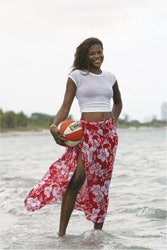Gender equity in the post-Title IX era hasn't translated to the marketing of women's sports, where eye candy still trumps athleticism.
 Anna Kournikova
Anna Kournikova
Meanwhile, in a parallel universe, the NBA unveiled its new ad campaign...
They are men. They are not robots programmed to play basketball and do nothing else. They are fathers, sons, brothers and husbands. They have master's degrees, Ph.D.s and second careers. They enjoy dressing up, having fun and hanging out.
Says the Los Angeles Lakers' Lamar Odom, "The commercials identify with the fact that we are men and we play a game and have different personalities; whether that is being glamorous, being tough, being innocent or not being innocent. We are beautiful men, but at the same time we play a sport that we love."
Is this any way to sell a sport? The Women's National Basketball Association thought so - it ran this campaign prior to the 2003 season, the league's seventh. Dubbed "This Is Who I Am," the ads featured eight of the league's marquee players, interspersing on-the-court action with footage meant to invoke their off-the-court personae. And so the L.A. Sparks' Lisa Leslie (who is the actual author of the quote attributed here, with sincere apologies to Lamar Odom) was shown striding down a catwalk wearing an evening dress and heels, and in a hooded, blue Lycra bodysuit; Ticha Penicheiro of the Sacramento Monarchs stood beside a yellow sports car wearing a tight black leather outfit; and Swin Cash of the Detroit Shock posed in overalls in front of a steel mill.
Sparks forward DeLisha Milton, who was not featured, denied at the time that the WNBA was selling sizzle rather than steak, but her words told a different story. "Wow, if those same people saw us go out to the club some night," she said, referring to the league's critics, "they might think we are prostitutes. We are just women in our prime. We are young, like to have fun and keep up on the latest fashions."
A person familiar with the women's movement and the gains made by women athletes in the post-Title IX era could be forgiven if her or his head began to spin upon hearing the tone, as well as the substance, of Milton's remarks. Excuse me? Am I missing something? Is she? They might think we are prostitutes. We like to have fun. Welcome to the marketing of women athletes in the new century.
The L-Word
By the time Sheryl Swoopes of the Houston Comets appeared in the "This Is Who I Am" ad campaign, she was a two-time league MVP, having won the award in 2000 and 2002. She was widely acknowledged as one of the greatest women to have ever played basketball, the holder of three Olympic gold medals and the NCAA record for points in a title game (47). She was also widely celebrated as a new paradigm of professional athlete - in the WNBA's infancy, she appeared in advertisements for the league as a pregnant, married athlete who would sit out most of the first season because of the birth of her son.
In 2005, Swoopes won the MVP for a third time, and then held a press conference in October to declare that she was a lesbian. "This is who I am," she said without apparent irony, "and it's okay."
One of the big surprises of the Swoopes announcement is just how okay it has been to nearly everyone who has bothered to comment on it. WNBA fans posting messages in the league's chat rooms have been outspoken in their respect and admiration for Swoopes, Nike (her biggest sponsor) and the league issued immediate statements of support, and the sports media gave it big play in the initial news cycle - and then, just as quickly, dropped it.
"It was a significant moment, because Swoopes showed that a traditionally attractive woman who was married and is a mother and the all-American girl next door could also be a lesbian," says Mary Jo Kane, director of the Tucker Center for Research on Girls & Women in Sport at the University of Minnesota. "It was also significant that it was basically a one-day story, and the reporters were very positive about her coming out. It shows a clear shift from the days when, say, Billie Jean King was outed."
Homosexuality in sports, though, continues to be a concept that corporate America has trouble getting its collective brain around. This is true even though the WNBA as a league has (and its teams separately have) specifically targeted lesbians as a key fan demographic.
"The WNBA has embraced the gay and lesbian community in terms of reaching out through ticket programs and marketing to them specifically with an empowerment message to women: 'Come and support other women who are on the floor,' " says Paul Swangard, managing director of the University of Oregon's Warsaw Sports Marketing Center. "At the same time, since replacing Val Ackerman as league president, Donna Orender has been very passionate about reaching the mom and dad who want to bring their kids to a reasonably priced entertainment experience to watch basketball that's played below the rim - as she argues, the way it was meant to be played. That's a whole different set of messages, a different marketing strategy."
And, it should be noted, many of the WNBA's fans believe that its support of Swoopes has been tepid. If anything, critics say, the league has tried to reach out to the gay and lesbian community as quietly as possible.
Becky Heidesch, president and CEO of WSS LLC (formerly Women's Sports Services), sees stealth as a necessary strategy in a polarized society. "Put it in a political perspective," she says. "By embracing one constituency, you alienate another. But also, there are certain to be people who walk into the arena and if in their view there is a gay and lesbian audience there, are they going to return with their kids and family? There are going to be corporations who embrace the market, and others who will say, even if it's a good business move, 'We don't want to be in that space.' It's a challenge for any marketer: You don't want to alienate anyone." Kane, though, sees in this a whiff of homophobia, which she calls "the DNA of women's sports."
"The WNBA has tried to straddle the issue, since the league and its sponsors are enormously concerned about producing a wholesome image," Kane says. "Leagues like the WNBA see themselves in a very difficult position, but it's a false dichotomy. Lesbians are not anti-family: They have families, and they come from families. So it's not a contradiction in terms, and yet leagues operate under that assumption."
If the league isn't completely comfortable discussing the subject (league officials repeatedly declined AB's requests for comment), its fans seem to be. And that, Kane says, portends an eventual change in the perception and acceptance of women's sports.
"It's a cultural shift, it's not just happening in sports," she says. "I don't want to overstate it, as if we've opened the door so all the female coaches and players who are lesbians can come out. It doesn't mean there isn't resistance and backlash. But space has been opened up for change to come."
Booters with Hooters
The most valuable body part belonging to an American soccer player in the 1999 Women's World Cup final was not a breast or a leg, but a skull. It belonged to Kristine Lilly, whose clutch header of a shot about to give China the title in sudden-death overtime allowed Brandi Chastain's bare midriff to subsequently gain international acclaim.
Even the details of Chastain's Cup-clinching shootout goal got lost in the veritable media orgy that followed her on-field celebration. A representative description was provided by Mike Penner of the Los Angeles Times: "Off went the top in one delirious clean and jerk, leaving her clad in a black sports bra. Chastain brandished the jersey as if it were a lasso, whipping it over her head and the crowd into a frenzy."
The picture was worth 1,000 words, at least, and it became one of the more famous covers to grace Sports Illustrated. But you can't really blame the media for getting overheated; various members of the U.S. women's soccer team eagerly abetted their objectification as far back as the 1996 Olympics, when Brianna Scurry made good on her promise to run naked through the streets of Athens, Ga., after the team won the gold medal - a moment of unrestrained joy that nobody forced her to publicize. It was co-captain Julie Foudy who christened the team "Booters with Hooters," Chastain who posed nude with a soccer ball in Gear magazine, and a group of players who on the eve of the 1999 Women's World Cup presented David Letterman an autographed team photo in which the team wore "Late Night" T-shirts and nothing else.
Everyone agrees: Sex sells. But what does it sell?
Kane and others in the academic world have a word for the typical marketing portrayal of women athletes - "heterosexy" - which has several implications for women athletes. One is that there is pressure from sponsors (not to mention from within) to maintain an image of femininity that conforms to the prevailing stereotype of women. This is something that is not expected of male athletes and is objectionable to many women - but for the sake of "marketability," these appearances must be kept up. Sheryl Swoopes
Sheryl Swoopes
Another implication is that women's sports aren't valued by the culture absent the interest of men - and some women in the marketing field even support this view. Mary Lou Youngblood, chief operating officer of WSS, notes that the Ladies Professional Golf Association, her firm's career partner, actively promotes sexy images of its golfers on its web site. "They feel it's important that people see them as women first and athletes second," is the way Youngblood puts it. Asked why, she adds, "I guess they feel they need to do that in order to bring the men into the game."
But, she is asked, does the LPGA need to attract men?
"I think they have to," she says. "One, it brings in the kids. Two, it just gives the sport more credibility."
Others in the marketing field reject this idea, saying that if sex has helped women's sports, the evidence for it hasn't shown up on the balance sheet.
"It's almost the easy way out for marketers," Swangard says. "We try to argue with our students and our industry partners that sex is just part of the entertainment economy, and that it's not a way to build a loyal fan base. I don't think those of us who grew up to be sports fans did so because of the sex appeal of sport. Sex appeal creates awareness and buzz, but that's just the first step on a marketing stairwell. From a marketing standpoint, awareness is not a conversion tool."
Kane agrees.
"I'm not aware of any marketing research that shows that when you market female athletes in terms of their sexuality and their femininity, as opposed to their athletic competence, you sell more seats," she says. "You may sell more magazines - to men - but I haven't seen any data that shows how that translates into an increase in ticket sales or television contracts."
She Got Game
One last implication for women's sports is that they are still judged, in the media and around the water cooler, by the yardstick of men's sports. WNBA athletes can't sail above the rim, LPGA players can't drive the green, and women football players - ugh.
"I show the males in my classes images of women as competent athletes in action versus females in soft-porn or girly-girl images," Kane says. "I say to them, 'I assume the soft-porn images make you more interested in her in terms of a pretty body, or somebody who you might want to go out on a date with, or have sex with, but does that make you more likely to want to go to her sporting event?' Absolutely not. One guy asked me, 'What happens if you start emphasizing bodies in women's sports that are big and fat and are the antithesis of femininity?' That's the dilemma." (See "Perceptions: The Sixth 'P,' " p. 38.)
To a certain extent, we're stuck with the current paradigm, for while beauty may be in the eye of the beholder, advertising is still in the business of selling a particular ideal for what corporate America sees as the most desirable demographic - willowy, white and (usually) blonde. Thus, snowboarders Lindsey Jacobellis and Gretchen Bleiler were on the public's radar well ahead of the 2006 Winter Olympics, respectively hawking Visa cards and posing in nothing but body paint on the cover of FHM. (Before Bleiler finished second in the women's halfpipe to Hannah Teter, she complained that people didn't pay enough attention to her athletic skills - go figure.)
"We as a society like an attractive package, whether we're buying a car, a home or clothing," Heidesch says. "It comes into play even when you're packaging women's sports today."
"Stripping away the blondeness for a second, it is a personality-driven thing, too, even in the male space," Swangard adds. "Tim Duncan has arguably been the best NBA player over the past three or four years, but the guy is not coveted by marketers because he doesn't have an 'it' factor. Personality traits, charisma, leadership qualities, looks - these surround any athlete. With women, for whatever reason, greater weight is given to looks. That can be mitigated over time by other athletes emerging who have 'the look' but then are able to show all those other ingredients. The person people are pointing to as a real litmus test is Maria Sharapova. She has the Anna Kournikova thing, but she can back it up with tennis talent. Someone like her may help set the stage for a fuller appreciation of the incredible talent that exists in women's sports."
We're also, to a large extent, stuck with a sports culture that gives women athletes less than 10 percent of the available airtime on television and column inches in newspapers. The Women's Sports Foundation has for years charged that the neglect of women's sports is willful, that (as Kane puts it) there is "enormous, active resistance to women's sports being taken seriously" because "sports in this culture - in terms of who markets it, who consumes it, who talks about it - is dominated by men."
That's how Nike ads like the one centered on 1,500-meter runner Suzy Hamilton during the 2000 Olympics get to be mainstream entertainment - until they're pulled because of viewers' complaints. In that vignette, a scantily clad Hamilton successfully avoided being attacked by a chainsaw-wielding maniac. As Kane describes it when the subject arises in marketing symposia, "The underlying message was that female athletes might have stalkers, but hey, if you wear these shoes, maybe you can outrun 'em!"
Kane is convinced that fans of women's sports attend games and watch on TV for the same reason that men do: The athleticism. But while the greatest hope of women might be in the current generation of media and marketing professionals being supplanted by a younger, more sensitive generation, Kane thinks the changes should come sooner rather than later.
"I do think you can market women athletes as athletes," she says. "We've tried it the other way for 40 years. What's it done? Why don't we try to market women as competent, great athletes and see what that does?"
































